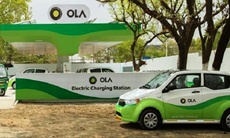Ola’s Nagpur experiment shows long road ahead for India’s EV dream
10 Mar 2018
Indian ride-hailing firm Ola's pilot project to test a fleet of electric vehicles in Nagpur, Maharashtra, was expected to herald a revolution in the Indian auto industry. However, it has only exposed weaknesses in the government's ambitious plans to make all new vehicles electric by 2030, according to a Reuters report.
 SoftBank-backed Ola launched the project last year with an initial investment of about $8 million.
SoftBank-backed Ola launched the project last year with an initial investment of about $8 million.
But nine months later, the program has hit a major problem - unhappy with long wait times at charging stations and high operating expenses, Ola drivers want to return their cars and switch to fossil fuel variants.
Out of 20 Ola electric car drivers interviewed by Reuters in Nagpur, more than a dozen said they have either returned their electric taxis and switched to diesel, or are planning to do so. The cars are owned by Ola and leased to drivers for Rs1,000 a day, but many complain that the amount is too high and they need to work for 12-16 hours to make a decent living, given that they waste 3-4 hours a day on charging.
Ola had said it would make 50 charging points available across four locations in Nagpur - a city of about 2.5 million people - for its fleet of 200 electric vehicles, but on a visit to the city in late January, Reuters reported it found only about a dozen charging points. Ola has since added 10 additional charging points but is still short of its target.
Ola did not respond to Reuters requests for comment for its report.
"The hurdles faced by Ola in setting up sufficient charging stations for a fleet of expensive electric cars with a limited driving range expose the challenges the Indian government and automakers will face if they are to get anywhere near realizing the 2030 vision," reuters said.
Global auto makers have repeatedly warned that India is not ready yet to become an only EV market, in the absence of a clear, long-term policy, provide incentives to encourage manufacturing of electric vehicles to bring down their cost and create the charging infrastructure.
Gadkari added to uncertainty when he said last month that the government will no longer draft a separate electric vehicle policy, without commenting on the 2030 vision.
The Ola project has not turned out to be economically viable for either the company or its drivers, the Reuters report said.
Electric car sales in India, one of the world's fastest-growing auto markets, made up less than 0.1 per cent of annual sales of more than 3 million passenger cars. The lack of demand is mainly because of costs due to high battery costs, limited battery range and lack of a charging infrastructure.
Mahindra & Mahindra is the only electric carmaker in India and the high cost of even its entry-level model, which starts at Rs7.6 lakh is a barrier for many first-time car buyers, and a non-starter for taxi drivers who can get a diesel or petrol propelled car for about half the price.






















